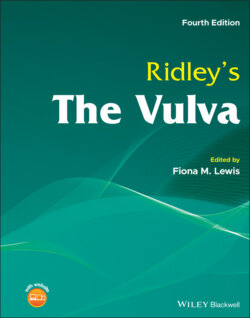Читать книгу Ridley's The Vulva - Группа авторов - Страница 182
Topical steroids
ОглавлениеTopical steroids were first used in the 1950s and revolutionised the treatment of many dermatoses, although the mechanism of their anti‐inflammatory action is not fully understood. Since the initial introduction of topical hydrocortisone, many different compounds have been formulated, and they are ranked in order of potency by their ability to produce vasoconstriction on the skin [4]. In the United Kingdom, there are four classes of topical steroid, whereas in the United States there are seven categories (see Tables 8.1 and 8.2). The classification of some steroids differs in each system, which may lead to confusion.
A combination preparation of a topical steroid with an antibacterial or anticandidal agent can be useful if there is secondary infection, but sometimes the antimicrobial agent can be the cause of a contact allergy. It is helpful to become familiar with at least one preparation from each category, and to tailor the strength and vehicle to the clinical situation. Ointment formulations are always preferable.
If used correctly, topical steroids are safe on the vulva [5,6]. Patients are often anxious about the potential side effects and therefore do not use them adequately to obtain the optimum results. Their worries can be further reinforced not only by family and friends but also by healthcare professionals. Many of the product information leaflets included in the packaging state that they should not be used on the genitalia, and a thorough explanation on the safe use of topical steroids for vulval disease needs to be given to the patient. Topical steroids are safe to use in pregnancy, and a systematic review shows no link of exposure to topical steroids and pregnancy outcome [7]. There was a possible link of low birth weight with the use of large quantities of topical steroids, but this would not be relevant for the small amounts used to treat the vulva.
Table 8.1 UK classification of topical steroids.
| Class | Potency | Examples |
|---|---|---|
| I | Mild | 1% hydrocortisone |
| II | Moderate | Clobetasol butyrate 0.05% Fludroxycortide |
| III | Potent | Betametasone valerate 0.1% Betamethasone dipropionate 0.05% Mometasone furoate 0.1% |
| IV | Superpotent | Clobetasol propionate 0.05% Diflucortolone valerate 0.3% |
Table 8.2 US classification of topical steroids.
| Class | Potency | Examples |
|---|---|---|
| I | Superpotent | Clobetasol propionate 0.05% Betamethasone dipropionate 0.05% |
| II | Potent | Mometasone furoate 0.1% |
| III | Upper mid‐strength | Betamethasone valerate 0.1% |
| IV | Mid‐strength | Fluocinolone acetonide 0.03% |
| V | Lower mid‐strength | Fluticasone propionate |
| VI | Mild | Fluocinolone acetonide 0.01% |
| VII | Least potent | 1% hydrocortisone |
The vulva is an area that is naturally occluded and therefore the penetration of the steroid is enhanced. It has been shown that there is a ‘reservoir effect’ in flexural areas in which the steroid can stay in the stratum corneum for up to two weeks. The topical steroid therefore needs to be applied only once daily [8]. When deciding about the correct amount to prescribe, a useful measure is the fingertip unit [9]. This is the amount squeezed from a standard tube that covers the distance between the distal interphalangeal joint and the tip of the index finger and equates to approximately 0.5 g (Figure 8.2). About half of this, or a pea‐sized amount, is adequate for one application to the vulva. In general, tapering regimens are used so that the frequency of application is reduced over time. This helps to prevent tachyphylaxis, where there is loss of effect with continuous treatment.
Intralesional injection of steroid can be helpful in hyperkeratotic lesions such as hypertrophic lichen planus or nodular prurigo. Foam preparations, such as those used in inflammatory bowel disease, are helpful for intra‐vaginal use. Other options include prednisolone pessaries or a small dilator coated with a topical steroid ointment in conditions such as erosive lichen planus.
Figure 8.2 Fingertip unit.
